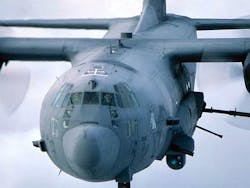ARLINGTON, Va., 11 July 2013. Military radar experts at the U.S. Defense Advanced Research Projects Agency (DARPA) in Arlington, Va., are looking to the L-3 Communications Corp. Electron Devices segment in San Carlos, Calif., to design and flight test an imaging radar system that enables U.S. aircraft to engage maneuvering ground targets through clouds dust and other obscurants.
DARPA on Monday awarded a $2.6 million contract to L-3 Electron Devices for the Video Synthetic Aperture Radar (ViSAR) System Design and Development program, which seeks to develop a prototype radar that can detect and track moving targets through clouds with the same ability that current infrared targeting systems have in clear weather.
The goal of the DARPA ViSAR program is to overcome weather limitations by developing an active radar sensor that enables the U.S. Air Force AC-130 gunship and other U.S. aircraft to image, track and target maneuvering ground targets through clouds, dust or other obscurants.
This new capability would increase the amount of time close-in air support is available and deny the enemy the ability to protect himself by operating in cloudy weather conditions, DARPA officials say. This capability also would also enable U.S. aircraft to use clouds as a screen while attacking ground targets with the ViSAR system.
The AC-130 gunship is the primary application for this effort, and L-3 Electron Devices engineers will design the ViSAR system to match the capabilities and dimensions of that aircraft.
The AC-130 is a heavily armed ground-attack aircraft variant of the Lockheed Martin C-130 Hercules four-engine turboprop transport designed for close air support. Its armament ranges from 7.62-millimeter machine guns to 105-millimeter cannon.
For this contract L-3 Electron Devices will develop a high-power synthetic aperture radar transmitter amplifier, and well as build and demonstrate a ViSAR system that provides the same targeting capabilities through clouds as current infrared targeting systems provide in clear weather.
After developing the ViSAR system, L-3 Electron Device experts will integrate and flight test it for possible eventual installation in the AC-130 gunship.
Close-in air-support systems like the AC-130 typically use infrared targeting sensors to attack moving ground targets such as vehicles and infantry soldiers, DARPA officials explain. The inability for infrared sensors to image through the clouds, however, limits close-in air support to clear weather.
Some regions of the world experience cloud cover that limits close air support for nearly half the time. Once engagements commence, moreover, infrared sensors are unable to image through the dust caused by explosions and incoming rounds.
L-3 engineers will seek address these shortfalls by developing a radar system that can provide the same performance through clouds as infrared systems provide in clear weather.
L-3 will design sensor technology to accommodate several possible future configurations for the ViSAR system, including installation onto an airborne pod, or integration into a 15- or 20-inch EO/IR gimbal.
L-3 Electron Devices experts will build on previous ViSAR work to develop flyable extremely high frequency (EHF) radar exciters and receivers, synthetic aperture radar scene simulation tools, and EHF radar-processing algorithms.
Last fall DARPA awarded contracts to the BAE Systems Electronic Systems segment in Merrimack, N.H.; the Raytheon Co. Missile Systems segment in Tucson, Ariz.; Nuvotronics LLC in Radford, Va.; and the Northrop Grumman Corp. Electronic Systems segment in Linthicum, Md., to develop EHF video synthetic aperture radar technology able to provide high-resolution imagery at high frame rates while minimizing size weight and power (SWAP).
DARPA asked BAE Systems, Raytheon, Nuvotronics, and Northrop Grumman to develop revolutionary technological advances, not simply improvements to existing radar technology.
For more information contact L-3 Electron Devices online at www2.l-3com.com/edd, or DARPA at www.darpa.mil.



